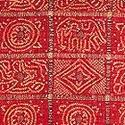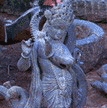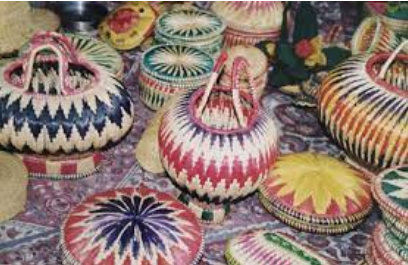The gharchola is the traditional Hindu and Jain wedding sari. The numbers of squares in it is ritually important – the number of squares are multiples of nine, 12, or 52. It used to be made of cotton but now silk is predominantly used.
The gharchola is essentially a bandhani sari. The technique of tie-dyeing cloth so that many small resist dyed spots produce elaborate patterns over the fabric is known as bandhini (bandhej) in the western Indian state of Gujarat.
History and Tradition
The bandhani technique is ‘believed to have existed in India since at least the late fifth century AD… but many of today’s western Indian [craftspeople] trace their ancestry back only two or three hundred years, to Pakistan’s Sind and Punjab.
Bandhanis are of various kinds:
|
According to Lynton: The ‘ghar’ is gharchola can be directly translated as ‘house’; however, it also connotes ‘birthplace’ and/or ‘family’, suggesting perhaps that the sari is from the home or birthplace of the brde (Lynton: p. 191).
Colours, Techniques and Motifs
The gharchola is a ‘single-colour saris…with white spots’. It is often red, though it can also be green. The network of squares is created by rows of white tie-dyed spots or rows of zari. Single motifs are created within each square – parrots, elephants, dancing girls, flowers – symbols of fertility, prosperity and joy. Sometimes zari is woven in, in discontinuous supplementary-weft patterning.
The making of the gharchola is a complicated and time-consuming process. A starched silk odhini or sari is fixed to a large wooden frame using nails. The sari/odhini, coloured red or green, is divided into a network of squares by rows of white tie-dyed spots or woven bands of zari. Motifs are then created within each compartment.
Gharchola is a variant of bandhani/tie and dye sari that is draped over the head and across the shoulders and is gifted to the bride by her mother-in-law. It is tied to the shawl worn by the groom in an auspicious marital knot.
Gharcholas are made in the Khambat and Jamnagar areas of Gujarat. The water quality of these regions is said to be suitable for dyeing and making the colors extra vibrant. Gharcholas made in other areas of Gujarat are different in style and finesse.
Traditional Indian auspicious colors like red/maroon and green/yellow are used in a gharchola. Contemporary gharcholas come in all possible shades of the colors red and green. Yellow is used as a substitute for green color. Nowadays, the use of different color combinations is common to weave a gharchola.
Venkatgiri cotton that is used to make the gharchola has a silk-like quality and sheen. It is an absorbent and resilient handloom fabric that is manufactured in southern India. Gharchola can also be made from a silk-cotton blend.
Gharchola can be recognized by its typical grid-like pattern. The most popular ones are nine, twelve, and fifty-two squared pattern. The twelve square grids are called ‘bar bagh’, while the fifty-two square grids are called ‘baavanbagh’.
Traditionally, gharcholas are made on the handloom using fabric and zari threads. Zari work is a characteristic of every gharchola. Each box in the grid-like pattern of gharchola is bordered with zari or metalwork. The woven fabric is tied in such a way that each box has a bandhani motif.
The motifs are those of parrots, peacocks, elephants, dots, human figurines, and the likes. The design that is predominantly floral is called ‘phulwari’/garden, whereas the fauna dominated design is called ‘shikari’/hunting scene.
After it is tied, the sari is dyed in the desired base color. Gharchola is further ornamented with intricate, hand embroidery. The embroidery could be done in zari,gota-patti, cut dana, and diamonds.
Traditional gharcholas have no separate colored pallu or border. There is zari work but the sari is of a single color. In contemporary gharcholas,bhrat/extra borders and pallu in green color are woven and attached separately.
Earlier, gharchola was a separate attire to be worn by the bride in a different ceremony. The common practice in today’s time is for a Hindu or Jain bride to wear the gharchola along with the panetar.
Panetar is the traditional wedding attire. It is gifted to the bride by her maternal uncle in some parts of Gujarat. It is characterized by its white/off-white color and bright red/maroon border and pallu. Traditionally, it was made of fine silk but over the years the fabric has changed with the changing trends.
Originally, this bridal sari was green in color. During the time of India’s independence, the colors saffron and yellow were included. Post-independence the sari became white in color and the border and pallu were dyed in red or maroon.
The panetar and gharchola saris are made by the Chhipa and Khatri communities of Gujarat. Although the panetar is machine woven the embellishment work and embroidery are done by hand.
The traditional panetar was made with gajji silk and had linear stripes or thin checks of gold zari. The red or maroon border and pallu were decorated with bandhani or tie and dye. The motifs were simple dots in either white or yellow. Then the sari was embellished in sequins and stones. Today, from fabrics, colors, and motifs to embroidery and embellishments the panetar bridal sari has taken on a more abstract and modern aspect to appeal to the newer generations.
Gallery
YOUR VIEWS
PRACTITIONERS: INDIA
Access 70,000+ practitioners in 2500+ crafts across India.
BIBLIOGRAPHY
10,000+ listings on arts, crafts, design, heritage, culture etc.
GLOSSARY
Rich and often unfamiliar vocabulary of crafts and textiles.
SHOP at India InCH
Needs to be written.






